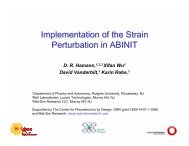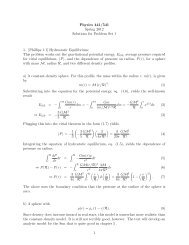7. Interference of Sound Waves
7. Interference of Sound Waves
7. Interference of Sound Waves
Create successful ePaper yourself
Turn your PDF publications into a flip-book with our unique Google optimized e-Paper software.
2011 <strong>Interference</strong> - 6<br />
Warning: Do not exchange your transducers with those from other tables;<br />
your three transducers are a matched set.<br />
Measure the period <strong>of</strong> oscillation directly from the oscilloscope's screen, taking into<br />
account the sweep rate (“M” value at bottom-center <strong>of</strong> screen). To make the period<br />
measurement as accurate as possible, measure the time interval corresponding to several<br />
complete oscillations. That is, measure the total time interval and divide by the total<br />
number <strong>of</strong> waves. Use the fine rulings <strong>of</strong> the square boxes to obtain a precise value. The<br />
reciprocal <strong>of</strong> T is f. Compare the frequency fo determined with the oscilloscope with both<br />
the frequency fsg <strong>of</strong> the signal generator and the frequency provide by the oscilloscope in<br />
blue in the lower right corner <strong>of</strong> the screen. The latter two values will likely be more<br />
accurate than your computed value, but the point is to gain an understanding <strong>of</strong> the<br />
information conveyed by the oscilloscope traces.<br />
A more precise way to measure the period, which exploits special features <strong>of</strong> the<br />
oscilloscope is as follows. Press the Cursor button near the middle <strong>of</strong> the dozen buttons<br />
at the top <strong>of</strong> the face <strong>of</strong> the scope – this will now change the on-screen Menu on the right<br />
<strong>of</strong> the scope screen. The Menu selections can be made by pressing on the buttons<br />
immediately to the right <strong>of</strong> the screen; press the button to the right <strong>of</strong> Type (twice) so that<br />
the Time cursors are activated. Beneath Type the word “TIME” will appear in a white<br />
box, and you should now see two vertical lines on the screen. If beneath Source you see<br />
“Ch 1” or “Ch 2” the vertical lines will be yellow or blue respectively. Either will do<br />
since both traces pertain to waves <strong>of</strong> the same frequency and period. However, if you see<br />
neither “Ch 1” nor “Ch 2” you will need to press the button to the right <strong>of</strong> Source until<br />
you are in one <strong>of</strong> these settings. Turn the knobs labeled VERTICAL Position CURSOR 1<br />
and CURSOR 2 (i.e. the knobs which usually move the traces the left and right) to move<br />
the vertical lines left and right. Align one with a wave crest (or trough) to the left <strong>of</strong> the<br />
screen and one with a wave crest (or trough) to the right <strong>of</strong> the screen. Then the read out<br />
on the right <strong>of</strong> the screen in blue or yellow will say DELTA beneath which will read the<br />
time interval between the vertical lines. This information can also be extracted from the<br />
difference in time values listed for Cursor 2 and Cursor 1 just below DELTA. You need<br />
only divide by the number <strong>of</strong> wave cycles in order to determine the period.<br />
3. Measuring wavelength<br />
The transmitting and receiving transducer stands fit over, and can slide along, a meter<br />
stick. With both transducers fixed in position, the two sinusoidal traces on the scope are<br />
steady. What happens to the scope trace from the receiving transducer when you move<br />
the receiving transducer away from the transmitting transducer? The traces are providing<br />
information about the relative phases <strong>of</strong> the transmitted and received sound wave (or the<br />
driving voltage and receiver voltage).<br />
Measure the wavelength by slowly shifting the receiving transducer a known distance<br />
away from the transmitter while noting on the oscilloscope screen by how many complete<br />
cycles <strong>of</strong> relative phase the wave pattern shifts. Don't choose just one cycle, but as many<br />
cycles as can conveniently be measured along the meter stick.


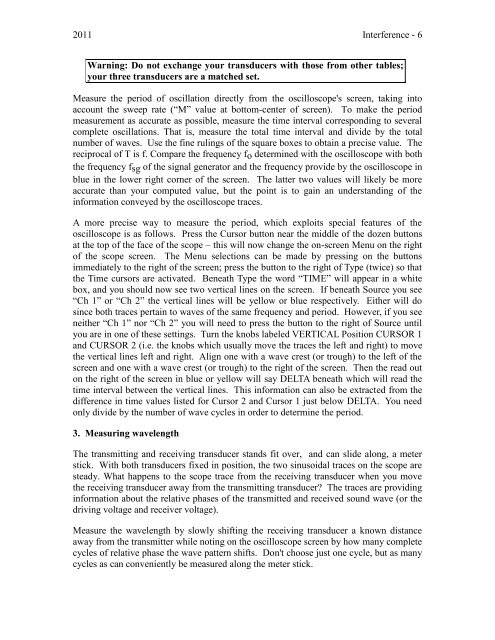

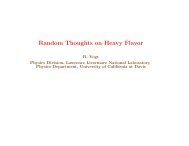
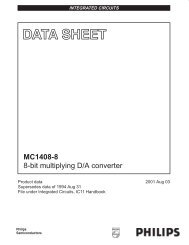

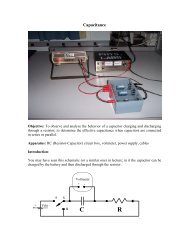

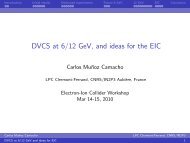
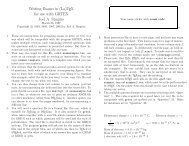
![More Effective C++ [Meyers96]](https://img.yumpu.com/25323611/1/184x260/more-effective-c-meyers96.jpg?quality=85)

